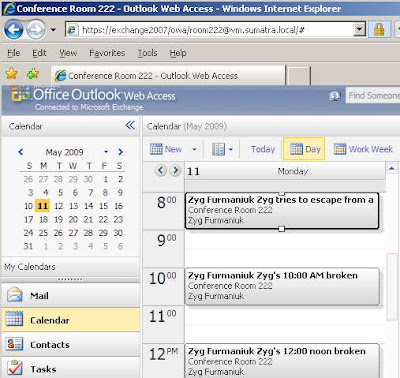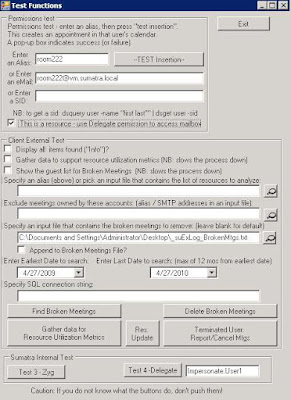MS released Exchange 2007 Rollup 9 for SP1 last week. The KnowledgeBase article (970162) reports twelve calendar, Outlook/OWA-related fixes:
- 954739 Exchange Impersonation feature does not work if a cross-forest topology has only a one-way trust relationship between forests (Ex07SP1)
- 961124 Some messages are stuck in the Outbox folder or the Drafts folder (Ex07SP1)
- 961544 Mobile users whose location is set to New Zealand cannot synchronize an exceptional occurrence after the daylight saving time (DST) update (KB 951072) is installed (Ex07SP1)CAS server
- 967479 Entourage clients cannot synchronize with mailboxes (Ex07Sp1/Win 08)
- 967525 Error 4 is returned when you synchronize a supported list of contact properties by using Exchange ActiveSync(Ex07SP1)
- 967676 E-mail address properties of contacts changed through Exchange Web Services (EWS) are not updated in Outlook or Outlook Web Access (OWA)(Ex07SP1)
- 968081 Monthly recurring meetings are declined if the "Schedule only during working hours" option is enabled(Ex07SP1)
- 968350 When you change the location field of a recurring calendar item to empty, the location field is set to the default value of the recurring series if this recurring item is synchronized on a Windows Mobile device (Ex07SP1)
- 969054 Error message after user replies to a message that has more than 300 recipients in Outlook Web Access (OWA): "Microsoft Exchange issued an unexpected response (500)" (Ex07SP1)
- 969324 Outlook crashes when you try to use Outlook to view e-mail messages that are arranged by subject in (Ex07SP1)
- 969838 An error message is returned when a user tries to change a recurring appointment in Office Outlook Web Access that was created in Outlook 2007 (Ex07SP1)
- 969969 OWA Error "Outlook Web Access has encountered a Web browsing error" when a user tries to delete a calendar item
 In an example of instant karma, the test site told us of a wonderfully simple short cut to permissions in setting up insertion (for those of you who have not been through a migration) based on BlackBerry Enterprise Server permissions, which we'll blog on separately.
In an example of instant karma, the test site told us of a wonderfully simple short cut to permissions in setting up insertion (for those of you who have not been through a migration) based on BlackBerry Enterprise Server permissions, which we'll blog on separately. Using our standard export tool on the OCS side, UNICPOUTU, this exports as:
Using our standard export tool on the OCS side, UNICPOUTU, this exports as: And will insert into Exchange just as you see.
And will insert into Exchange just as you see.  So in case we need to do Japanese or some other non-European character set we'll be able to respond.
So in case we need to do Japanese or some other non-European character set we'll be able to respond.  You'll notice that any of the recurrence pattern syntax is absent, as is any concept of the meeting ATTENDEES. Yes, you can take this and you can insert it as is into Exchange or any other calendar system that reads iCalendar. BUT without recurrences, attendees (and therefore attendee response status) and with no connection to managed conference rooms or resources.
You'll notice that any of the recurrence pattern syntax is absent, as is any concept of the meeting ATTENDEES. Yes, you can take this and you can insert it as is into Exchange or any other calendar system that reads iCalendar. BUT without recurrences, attendees (and therefore attendee response status) and with no connection to managed conference rooms or resources. It is CRUCIALLY better because while we are (still) lacking the recurrence patterns (don't worry, we re-create those), we have the attendee list and the attendee responses! This means we can re-create the full state of the meeting and make it live in Exchange. This also allows us to re-create the status in conference rooms.
It is CRUCIALLY better because while we are (still) lacking the recurrence patterns (don't worry, we re-create those), we have the attendee list and the attendee responses! This means we can re-create the full state of the meeting and make it live in Exchange. This also allows us to re-create the status in conference rooms.
 In the way of many marriages, Marge changes her name to Simpson after marrying her high school sweetheart, Orenthal.
In the way of many marriages, Marge changes her name to Simpson after marrying her high school sweetheart, Orenthal. If we change her name (leaving her alias alone) and go back into her calendar we note that the display name at the top is "Marge Simpson." New meetings are created as "Marge Simpson" but previously created meetings are still labeled "Marge Bouvier."
If we change her name (leaving her alias alone) and go back into her calendar we note that the display name at the top is "Marge Simpson." New meetings are created as "Marge Simpson" but previously created meetings are still labeled "Marge Bouvier."
 If Marge updates it (say by adding an agenda), the invitation comes into Russ's inbox looking like it's from Marge Simpson:
If Marge updates it (say by adding an agenda), the invitation comes into Russ's inbox looking like it's from Marge Simpson:
 SO NOW, let's look at it the other way: When the organizer modifies a meeting Marge is a guest in.
SO NOW, let's look at it the other way: When the organizer modifies a meeting Marge is a guest in.
 MARGE sees the following update come into her inbox (identifying her as Marge Simpson):
MARGE sees the following update come into her inbox (identifying her as Marge Simpson):










 How do we have the audacity to call it "broken?"
How do we have the audacity to call it "broken?"


 Pressing "Delete Broken Meetings" will remove them and log that to a report.
Pressing "Delete Broken Meetings" will remove them and log that to a report.





